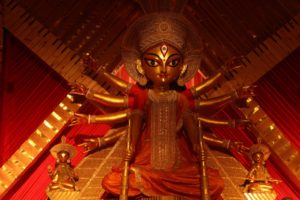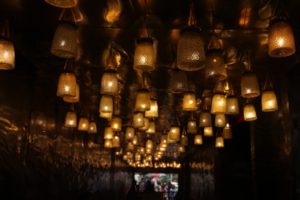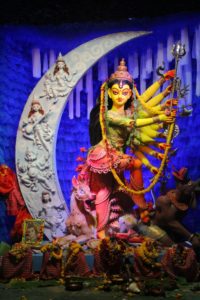The representative of feminine power in all its forms, Goddess Durga is at par with her male counterparts and is the sole deity to have nine days dedicated to her ritualized worship. A very important aspect of these rituals is the idol-making process which weaves several marginalized sections of the society closer if only once a year. With symbolism and irony often meeting one at every step, the idol-making process carries its own spiritual and symbolic value.

“Durga Puja, the 9-days long celebration of feminity, fertility, motherhood and festivity has just begun. But, this is just a tip of an iceberg. There are traditions associated with Durga Puja, which we have always heard partially but don’t know their actual background. Read it to know more.”
Kathamo – The Dawn of Creation
“There is no creation without tradition”
This quote by Carlos Fuentes perfectly describes the age-old tradition of idol-making in India. The images of Gods and Goddesses are a human creation. They weren’t people who existed that can be replicated in the form of idols, but instead they were ideas presented in the form of symbols and allegories in the ancient Hindu scriptures. These forms were created to explain something so incomprehensible, that it can’t be easily processed by the human mind.
Goddess Durga, being a significant goddess of the Hindu pantheon, is no exception to this tradition of idol-making. A multi-dimensional persona known for her power, resilience and potency, she is Mother Nature represented in the human form for the people to comprehend her abstract existence.
The festival centres on the ceremonial worship of goddess Durga which requires an idol that presents an integrated image of her in accordance with the mythological tales of Upanishads. The visual expressions are nothing but the metaphor of truth and knowledge captured in the artistic figurines prepared for this occasion.
There is also a lot of regional variations in the idols as different cultures shape them according to their own beliefs and historical experiences. Bengal doubtlessly is the centre of the idol-making process, specializing in creating almost life-like sculptures. Every year numerous masons and artisans engage in this handiwork to showcase their masterpieces for the festive occasion, not treating it like a task but a religious duty.
These idols are made in large numbers in the congested lanes of north Kolkata, the famous potter’s colony of Komortuli, locally known as pataupara. The kathamo puja is done on the rathyatra day which ceremonially indicates the beginning of the idol-making process. Kathamo is the Bengali name for a bamboo structure from which the pristine idol is made and therefore is apt for this particular occasion.
Traditionally, Goddess Durga represents the tantric school of thought which focuses on worshipping feminine divinity because of their ability to procreate, implied by their full rounded breasts (indicating the ability to feed their progeny) and buttocks (indicating the ability to give birth to many offsprings). Her image thus becomes a beacon of hope and fertility for the whole of mankind.

Punya Mati- Fabricating the Form
The process of creating Durga idols begins several days before the actual event. Bamboo sticks, which are placed to support the statue and the platform on which it is installed, form the cornerstone of the idol. On the day of Akshaya Tritiya, the artisans prepare the mould of clay in order to apply it to the bamboo frame and give it a proper form.
There is one particular tradition associated with this process that many find unusual in the context of the religious nature of this festival. The Bollywood movie “Devdas” further popularized this ritual involved in the creation of the Durga idol. The ritual of collecting Punya Mati, as it is commonly known, is the practice of procuring soil from outside the house of a prostitute in order to add it to the final paste of clay which is used to give shape to the idol’s form.
This, being a long-debated issue, has often been explained by the “intelligentsia” of our country as an aspect which can be understood through mythology. What this literati was unable to explain was, that even the mythologies are often constructed with moral and practical reasons at their core.
One largely accepted explanation states that the place around the brothel called ‘nishiddho pallis’ a Bengali term which translates to “forbidden territories”, is the place where people enter to satisfy their hedonistic pleasures leaving all their virtues and integrity behind. This makes the soil pious, filled with virtue and therefore a crucial element to be added to the clay.
Many people believe that this is done in accordance with the all-inclusive nature of tantric practices. This form of worship was essentially carried out by the people that were generally marginalized and excluded from the Vedic or Brahmanical framework of worship. As a result, it attracted women and Shudras alike. It should also be noted that Goddess Durga is epitomized as the mother Goddess which signifies that she is the mother of all beings and so, does not differentiate between her children.
Interestingly enough the Punya Mati (sacred soil) is to be begged and received from the hands of the prostitutes as a blessing. It gives an unusual power to these women as if to decide the fate of the patron which ironically is opposite to the conventional balance of power in the brothel.
Goddess Durga is an embodiment of righteousness and human vitality and we, as her devotees, should learn the lesson of shedding our ignorance and accepting all human beings, the same way she transcends class and caste divisions making her an idyllic figure within Hinduism.
Chhokhu Daan- The Final Touch
Seven days before the Durga Puja, the final day of Mahalaya breaks dawn which marks the end of ‘Pitri-paksha’ and the frenzied process of idol-making, with the start of the ‘Devi-paksha’ which invokes the festive mood for the Durga Puja. In the final stages, a coat of pink and yellow earth colours is applied to the sculpture. The features are made with intricate details which require great effort.

One of the most significant rituals of this auspicious day is the chokkhu daan- painting the eyes of the Goddess. On the night of Amavasya (new moon), people pray to Goddess Durga asking her to descend to earth and destroy all evil which lingers in the world as she bestows the world with her holiness.
On this particular day, the final detailing of eyes is done by the chief artist. Painting the eyes of Goddess Durga requires great patience and care. The literal meaning of chhokhu daan is “an offering of the eyes”, which is a metaphor for the realistic eyes the artist gives to the Goddess’s idol, almost as if donating their own eyes in the process. Before painting the eyes, the artisans fast for a day and eat only vegetarian food.
This is based upon the notion of eyes being very significant in Bengali Culture. The celebrated Bengali eyes which are typically large and almond shaped are characteristically known to act as the window to a person‘s soul. According to a legend, the three eyes of Goddess Durga were formed by Agni giving them the much ferocious look. Her dark eyebrows were produced from the two (morning and evening) twilights or Sandhya, and are popularly shown to be heavily lined with kajal under her slender long-lashes.
The final model of the idol radiates a bright yellow colour which is the colour associated with the colour of crops upon their maturity, another sign of energy associated with her fertility. She is then clothed, ornamented and her hair is made from jute along with an elaborate headdress which is placed over her head. Additionally, she is presented with many deadly weapons such as a trident and Sudarshan, each of which is supposedly gifted to her by several gods, along with a lion as her divine vehicle. This is the image of Durga as a supreme being who assumes the role of the creator, preserver and destroyer while maintaining the harmony of life.
A salutation
O mother Durga! I raise victory-slogans in your honour! Only you, Mother, is capable of solving the most distressing problem of your devotees. It is this reason that even the Gods ever remain in your service. O, Mahadurga Devi! The primal power, The Mother of all and the only support for men in the entire universe.
Author : Sukriti Vats

